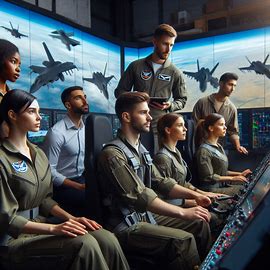
Introduction
Fighter pilot training is one of the most rigorous, complex, and critical elements of modern military aviation. Preparing for high-speed aerial warfare demands not only physical fitness and technical knowledge but also mental resilience and advanced tactical skills. In this comprehensive guide, we delve into how fighter pilots are trained for combat across different nations and programs.
1. The Journey to Becoming a Fighter Pilot
1.1 Selection and Entry Requirements
Becoming a fighter pilot starts with stringent selection. Candidates undergo a battery of tests and screenings to assess their aptitude.
Common Requirements:
- Excellent academic background in STEM
- High physical fitness and eyesight standards
- Psychological and leadership assessments
In the U.S., for example, aspiring Air Force pilots begin their journey at the Air Force Academy or through Officer Training School (OTS). Other countries follow similarly demanding paths.
1.2 Initial Flight Training (IFT)
Once selected, cadets begin Initial Flight Training, learning the fundamentals of aviation.
Key IFT Components:
- Basic aerodynamics and flight theory
- Hands-on experience in propeller-driven trainer aircraft
- Emergency procedures and communications
IFT establishes the foundational flying skills necessary for advanced combat training.
2. Advanced Tactical and Weapons Training
2.1 Undergraduate Pilot Training (UPT)
Undergraduate Pilot Training is where cadets transition to jet-powered trainers like the T-38 Talon or Hawk.
Curriculum Highlights:
- Formation flying
- Instrument navigation
- Aerobatics and combat maneuvers
Pilots are graded on precision, timing, and situational awareness.
2.2 Introduction to Fighter Fundamentals (IFF)
IFF serves as the bridge between UPT and full-fledged fighter training.
Focus Areas:
- Air-to-air combat tactics
- Gun and missile employment
- Offensive and defensive BFM (Basic Fighter Maneuvers)
This phase introduces the high-G environments and decision-making intensity of aerial combat.
3. Simulators and Virtual Training
3.1 Full-Motion Flight Simulators
Modern simulators allow fighter pilots to practice complex combat scenarios safely and cost-effectively.
Simulator Capabilities:
- Replicate G-forces and cockpit systems
- Simulate radar tracking, enemy threats, and weather conditions
- Offer real-time mission debriefing tools
Simulators can be networked for multi-pilot missions and red-blue force exercises.
3.2 Virtual and Augmented Reality (VR/AR)
Emerging tech is changing how pilots train.
Advantages of VR/AR Training:
- Realistic 360-degree battlefield views
- Reduced resource and maintenance costs
- Repetition of high-risk scenarios without danger
These tools enable rapid skill acquisition and mission rehearsal.
4. Live Fire Exercises and Dogfight Drills
4.1 Red Flag and Equivalent Exercises
Exercises like Red Flag (U.S.), Cobra Gold (Thailand), and Pitch Black (Australia) simulate realistic combat missions.
What Pilots Learn:
- Large-scale air operations
- Electronic warfare and threat avoidance
- Coordination with ground and naval forces
Such exercises provide a close-to-combat experience in controlled environments.
4.2 Dissimilar Air Combat Training (DACT)
DACT pits fighter pilots against different aircraft types.
Training Objectives:
- Exploit weaknesses of enemy aircraft designs
- Adapt to different combat strategies
- Improve survivability and decision-making
DACT enhances the pilot’s ability to handle real-world adversaries.
5. Mental and Physical Conditioning
5.1 High-G Training and Endurance
Combat pilots experience up to 9Gs during maneuvers. Specialized training helps build tolerance.
Training Methods:
- G-tolerance chambers
- Specialized exercises to improve core and leg strength
- Breathing techniques (AGSM)
Maintaining consciousness under G-loads is essential to avoid G-LOC (G-induced Loss of Consciousness).
5.2 Psychological and Cognitive Training
Fighter pilots must maintain sharp focus and quick thinking under stress.
Psychological Prep Includes:
- Stress inoculation training
- Cognitive enhancement tools
- Decision-making drills under pressure
Mental fitness is as important as physical fitness in aerial combat.
6. International Differences in Pilot Training
6.1 U.S. vs. Russian vs. NATO Methods
Training philosophies vary by nation. The U.S. emphasizes simulators and network-centric warfare, while Russia focuses on live-fly realism.
| Nation | Key Training Feature | Primary Aircraft |
|---|---|---|
| USA | High-tech simulators | T-38, F-22, F-35 |
| Russia | Aggressive live drills | Yak-130, Su-35 |
| NATO | Joint multinational | Eurofighter, Rafale |
6.2 Collaboration and Exchange Programs
Joint exercises and training exchanges promote cross-national readiness.
Examples:
- NATO Tiger Meets
- U.S.-India Cope India
- UK’s participation in Red Flag
These programs allow pilots to learn from a variety of doctrines and technologies.
Conclusion: Precision in the Skies Starts on the Ground
Fighter pilot training is a blend of physical conditioning, tactical knowledge, and psychological resilience. Through simulators, live drills, and international collaborations, modern air forces are producing pilots who are not only technically skilled but also combat-ready under pressure.
Which part of fighter pilot training do you find most fascinating—dogfighting drills, simulators, or G-force training? Share your thoughts and let’s discuss what it takes to become a top gun in today’s high-speed aerial battles.